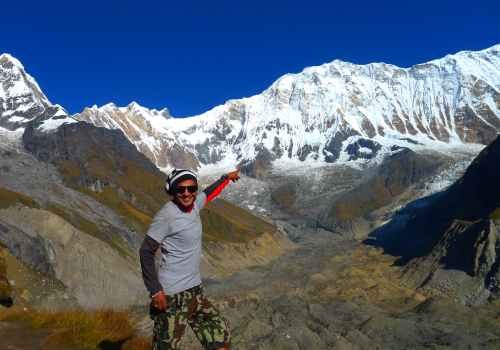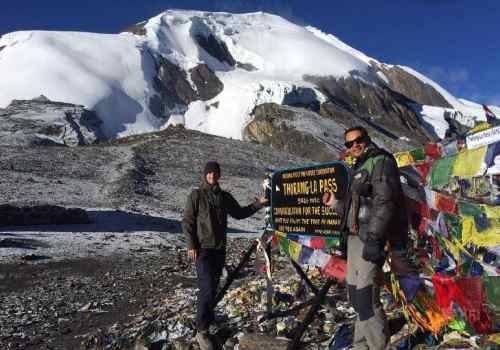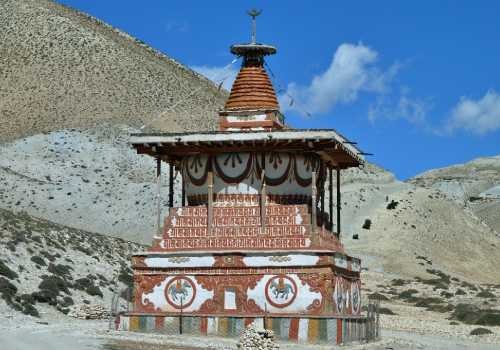10 Days Ghorepani and Poon Hill Trekking: "Scenic View-Point hill for Glorious Sunrise over an array of Himalayan Peaks."
Trekking Planner Inc. presents “10 Days Ghorepani and Poon Hill Trekking” where all age groups and interested travelers can join in this wonderful short country walks.
It is one of the most scenic and popular trek around the Annapurna Mountain Region as well as in the entire Himalayan Region. It is an opportunity for you to enjoy varied cultures, landscapes, and climates on this marvelous walk to the Ghorepani and Poon Hill Trek.
This marvelous adventure offers spectacular sunrise views over a 360-degree wide-angle snow-mountain range. Getting closer to the world's three highest peaks namely 7th high Mt. Dhaulagiri 8,167 m, 10th high Mt. Annapurna-I at 8,091 m (the first 8,000 m mountains ever climbed in 1950 by French Expeditions even before Mt. Everest was submitted) with 8th highest Mt. Manaslu 8,163 m high.
Ghorepani and Poon Hill Sunrise Trekking begins from picturesque and renowned touristic Pokhara, a city located on a verdant valley surrounded by green tiers of hills, and at the very laps of towering Annapurna Himalaya and majestic Machhapuchare Himal the famous ‘Fish Tail’ peak that touches serene Fewa Lake and Begnas Lakes.
Trek starts with a short drive into slow warm farm country and then climbs towards green alpine hills where temperatures change into cooler air as the walk takes you within lovely woods of tall rhododendron, magnolia, and pines, oaks, and fir trees.
Ghorepani and Poon Hill area located in the midst of forest will be a magic moment in springtime when wildflowers with rhododendron in the full bloom season.
On reaching Ghorepani on the highest village of the trek for an overnight stop in this nice Poon / Magar people, the hill tribe of western Nepal, where next early morning an hour climb takes you on top at Poon Hill.
Poon Hill offers stunning sunrise views over an array of Himalayan peaks as far as your eyes can take from the far west and towards the eastern horizon with rolling green hills, after a fantastic moment with a glorious panorama of mountains with sunrise.
The return journey takes you to an alternative scenic route with the ups and downhill walks into the serene forest to reach a large farm village in Ghandruk. This village is inhabited by the Gurungs of the Annapurna Himalaya Range. Enjoy exploring the village adorned with Buddhism, religion, and culture.
From Ghandruk a short walk downhill completes our walking journey as the drive brings you back to scenic and beautiful Pokhara, after a great wonderful experience on Ghorepani and Poon Hill Trekking.
Why Ghorepani Poonhill Trekking?
The Ghorepani Poonhill Trek is one of the most popular trekking routes in western lap of Nepal. The walk passes through magnificent mountain landscapes, including the as Dhaulagiri 8,167 m, Annapurna I 8,091 m, Annapurna South 7,219 m, Machapuchare 6,993 m, Machhapuchhre (Fishtail) (6,993m), Gangapurna 7,455 m,Tukuche peak 6,920 m, Dhampus peak 6,012 m, Hiunchuli 6,441 m, Gurja Himal 7,193 m, Nilgiri Himal 7,061 m. The vista from Poon Hill, which gives panoramic views of the surrounding mountains, is the highlight of the trek.
The following are some of the reasons why you should participate in the Ghorepani Poonhill Trek:
The views from Poon Hill are just spectacular.
- Scenic trek: the trek itself is highly scenic. You'll pass through rhododendron forests, rice farms, and small communities on your journey.
- People are nice and Hospitable: The people of Nepal are very kind and welcoming. You will have an amazing experience connecting with the locals on your journey.
- Cultural Immersion: The trek passes through traditional villages inhabited by Gurung and Magar ethnic groups. This allows you to immerse yourself in the local culture and enjoy the Nepalese people's warm friendliness.
- Rhododendron Forests: The trekking trail winds through lovely rhododendron forests. The rhododendrons in bloom offer a brilliant sight, adding to the natural beauty of the surrounds.
- Perfect for the Beginner: If you are a beginner with no trekking experience, this trek is ideal for you.
Ghorepani Poon Hill Trekking is an appealing option for those looking for a relatively short and enjoyable trek that combines breathtaking mountain vistas, cultural immersion, and a sense of accomplishment in gorgeous Annapurna Region.
Preparation for: 10 Days Ghorepani Poonhill Trekking.
Preparing for the Ghorepani Poon Hill Trek involves some physical fitness, appropriate equipment, and necessary arrangements. Trekking Planner Inc. recommends the following essential preparations for a 10 Days Trek:
Physical Fitness.
- You are highly suggested to begin a regular fitness regimen several months before the expedition. To increase stamina, focus on cardiovascular exercises such as hiking, jogging, or cycling.
- Strengthen your leg muscles, core, and upper body with strength training routines.
- To simulate trekking conditions, go on practice hikes or walks with a loaded backpack.
Permits for Trekking.
- You have to acquire the proper permits for the trek.
- The Ghorepani Poon Hill Trek requires an Annapurna Conservation Area Permit (ACAP) and a TIMS (Trekkers' Information Management System) card.
- Trekking Planner Inc. takes care of your permit when you book your trip with us.
Gear and Equipment.
- A durable and comfortable backpack (about 30-40 liters) to carry your essentials on the hike.
- Hiking boots that have been broken in to give ankle support and traction on uneven terrain.
- Base layers, fleece coats, and waterproof outer shells are all examples of lightweight, moisture-wicking garment layers.
- Trekking pants, quick-drying t-shirts, and long-sleeve shirts for sun and insect protection.
- Warm layers such as a down jacket, hat, gloves, and thermal socks are recommended for cold mornings at higher altitudes.
- A sleeping bag appropriate for cold weather (at least -10°C), as temperatures can plummet during the night.
- Trekking poles for stability and to avoid knee strain while descending.
Packing Essentials.
- Water bottles or a hydration bladder are required to stay hydrated during the walk.
- Energy bars to keep you going on the path.
- Wet wipes and toilet paper are examples of personal toiletries.
- To protect yourself from the sun's rays, wear sunscreen, sunglasses, and a hat.
- Basic substances, blister treatments, and any personal prescription prescriptions are included in the first aid pack.
- With spare batteries, use a headlamp or flashlight.
- Charge electrical devices with a portable charger or power bank.
- Cash (Nepalese rupees) for any additional costs, such as hot showers or refreshments.
Travel Insurance.
- Purchase comprehensive travel insurance that includes coverage for emergency medical evacuation, trekking-related injuries, and trip cancellation or interruption.
- Get a medical examination.
- Before you begin trekking, make sure you're in good health, especially if you have any underlying medical concerns. Your doctor can advise you on any necessary immunizations or medications.
Get a Medical Examination.
Before you begin trekking, make sure you're in good health, especially if you have any underlying medical concerns. Your doctor can advise you on any necessary immunizations or medications.
Be Mindful of the Environment.
- The Ghorepani Poonhill Trek takes place in a stunning and sensitive setting. It is critical to be environmentally conscious and leave no trace. This includes taking out all of your waste, following local customs, and not littering.
- Here are some other suggestions for your journey:
- Begin early. The optimum time to begin your walk is early in the morning to escape the heat of the day.
- Allow yourself plenty of time. There's no need to hurry on your journey. Take your time and take in the sights.
- Keep hydrated. It's essential to stay hydrated on your journey. Drink plenty of water, especially if the weather is hot or you're working out.
- Eat on a regular basis. It's also important to eat regularly while hiking. Pack some protein barss to keep your energy level high.
- Pay attention to your body. Take a break if you're feeling fatigued or ill. Don't overwork yourself.
- The Ghorepani Poonhill Trek is both beautiful and fulfilling. By following these guidelines, you may assure a safe and enjoyable walk.
What is the Best Season for Ghorepani and Poonhill Trekking?
Spring (March to May) and autumn (September to November) are considered as the finest seasons for Ghorepani and Poon Hill Trekking in Nepal. Here's what to expect in each season:
Spring (March to May):
- Temperature: Mild to moderate during the day, with colder evenings at higher elevations.
- Weather: Mostly sunny skies with a few clouds. Higher altitudes, on the other hand, may have some haze owing to dust and pollen.
- Rhododendron Blooms: The flowering of rhododendron forests along the trail creates a brilliant display during the spring season.
- Visibility: Excellent visibility, with stunning views of the Himalayan ranges.
- Crowds: There are a moderate to large number of trekkers, especially in April, when trekking is popular in Nepal.
Autumn (September to November):
- Temperature: Mild to mild, with warmer days and cooler nights at higher elevations.
- Weather: Generally dry and clear, with superb visibility and ideal trekking conditions.
- Mountain Views: The autumn season offers clear views of the Himalayan peaks, making it ideal for photography and taking in the breathtaking scenery.
- Festivals: The autumn season coincides with key Hindu festivals like as Dashain and Tihar, enhancing your trekking experience with cultural richness.
- Crowds: There are a moderate to large number of trekkers, especially in October, which is peak trekking season.
The Monsoon Season (June to August) is also fine for trekking, but the weather can be unpredictable, with the possibility of rain and landslides. The path also get slippery.
Winter (December to February) is an excellent season for experienced trekkers seeking a more strenuous adventure. It can get very cold at night, and there is a chance of snow.
Climate and Weather of Ghorepani Poonhill Trekking.
The climate and weather of Ghorepani Poonhill vary depending on the time of year. Trekking is best done in the spring (March to May) and autumn (September to November), when the weather is mild and sunny. The temperatures are relatively warm, making it a pleasant time to trek.
Here is a more complete analysis of the climate and weather of Ghorepani Poonhill Trekking that might help you to analyze:
- Spring (March to May): The weather is pleasant and sunny, with clear skies that allow for spectacular views of the Himalayas. The temperatures are relatively warm, making it a pleasant time to trek. The average temperature is between 15 and 25 degrees Celsius.
- Summer (June to August): Heavy rain and thunderstorms are common throughout the monsoon season. The trails can be wet and dangerous, and landslides are possible. The average temperature is between 20 and 30 degrees Celsius.
- Autumn (September to November): The weather is nice and sunny, with clear sky that provide spectacular views of the Himalayas. The temperatures are relatively warm, making it a pleasant time to hike. The average temperature is between 15 and 25 degrees Celsius.
- Winter (December to February): The weather is chilly and dry. The trails can be icy and dangerous, and snow is a possibility. The average temperature is between 0 and 10 degrees Celsius.
- When walking in Ghorepani Poonhill, it is essential to be prepared for any weather conditions. Pack proper attire as well as sunscreen, sunglasses, a hat, and a rain jacket and so on.
Here are some safety and health advice for trekking in Ghorepani Poonhill:
- Consult with your doctor before embarking to trek.
- Get yourself in shape.
- Pack the necessary equipment.
- Employ a Guide and a porter.
- Be environmentally conscious.
- Begin Early.
- Allow yourself plenty of time.
- Keep hydrated.
- Eat on a regular basis.
- Pay attention to your body.
The Ghorepani Poonhill Trek is both beautiful and fulfilling. By following these guidelines, you may assure a safe and enjoyable walk.
Local culture and tradition of Ghorepani Poonhill Trekking.
The Ghorepani Poonhill Trek is an excellent way to learn about Nepalese culture and traditions. The Gurung, Magar, and Thakali people live in the villages along the trail, each with their own set of customs and beliefs.
On the Ghorepani Poonhill Trek, you can learn about local culture and tradition in the following ways.
- Culture of the Gurung: The Gurung are a warrior people with a rich history and culture. They are well-known for their bravery, hospitality, and appreciation for music and dance.
- Thakali culture: The Thakali are a wealthy commercial people famed for their hospitality. They are also well-known for their distinct cuisine, which includes a wide range of meats and spices.
- Magar Culture: The Magar are an agricultural tribe who are recognized for their strong sense of community and love of environment. They are also well-known for their unique apparel and jewelry.
- You can engage in some of the traditional activities of the people you encounter along the trip, in addition to learning about local culture. You can, for example,
- Learn about the Gurung culture by visiting a Gurung village.
- Attend a Magar dance performance.
- Taste the food of Thakali.
- Discover how to create traditional Nepali handicrafts.
- The Ghorepani Poonhill Trek is an excellent method to learn about Nepalese culture and traditions. You can obtain a better knowledge of this interesting country by learning about the individuals you meet along the route.
On the Ghorepani Poonhill Trek, here are some more recommendations for learning about local culture and tradition:
- Be mindful of local customs.
- Inquire about the local culture and traditions.
- If possible, take part in traditional activities.
- Local companies should be supported.
Accommodation During Ghorepani Poonhill Trekking.
There are a variety of hotel alternatives along the Ghorepani Poon Hill Trekking. Teahouse lodges, often known as guesthouses or tea lodges, are the most frequent type of accommodation. Here's what to expect in terms of lodging on the trek:
- Teahouse Lodges: The most popular and commonly available accommodation choice along the trekking route is teahouse lodges. These are small mountain lodges that offer accommodations with basic amenities. The rooms usually contain twin or bunk beds, as well as mattresses, blankets, and pillows. It is, however, recommended that you bring your own sleeping bag for added warmth and comfort.
- Facilities: Teahouse lodges have community dining spaces where you can enjoy your meals. Most lodges offer a menu including Nepali and international dishes such as dal bhat (traditional Nepali meal), noodles, soups, and more. While the menus are rather diverse, please keep in mind that at higher elevations, the possibilities may be limited.
- Shared Bathrooms: The teahouse lodges usually have communal bathrooms. Basic squat toilets to western-style toilets are examples. Hot showers are offered in most lodges, but they are frequently charged extra. The supply and dependability of hot water may vary, particularly at higher elevations.
- Charging Stations: Most teahouse lodges feature charging stations for electronic devices such as phones and cameras. These, however, are typically limited and may come at an additional fee. Carrying a portable charger or power bank is a good idea to guarantee you have a backup power source.
- Internet and Communication: While some teahouse lodges have Wi-Fi, the connection may be poor and unreliable. It should be noted that Wi-Fi is not available in all of the lodges along the trekking route. Mobile network coverage may also be restricted or non-existent in some regions, especially at higher altitudes. Also, the tea houses charge extra for cost for charging.
It's important to remember that the facilities and comfort levels of the rooms may differ from one resort to the next. It is advised to keep a flexible and open attitude, realizing that the trek's emphasis is on natural beauty and experience rather than luxurious accommodations. Also, you need to be more considering during peak season, as the lodges may get full and there will be a crowd.
.jpg)



